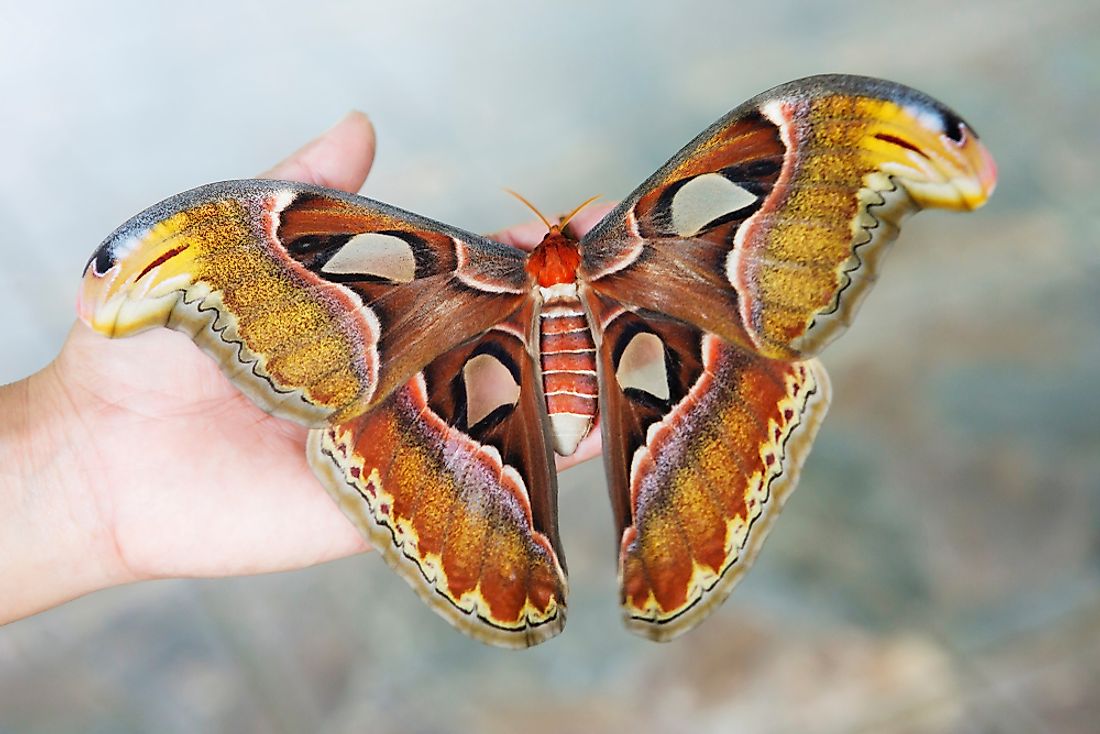What Is The Largest Moth In The World?

Moths are insects that are closely related to butterflies. There are approximately 160,000 species of moths, some of which are yet to be described. Although moths closely resemble butterflies, there are differences between moths and butterflies. The distinguishing feature is the antennae. A moth has a feathery antenna while a butterfly has a thin antenna with a small ball at the end of it. Moths vary in sizes and shapes with some having a large surface area of over 60 square inches. The size of a moth can be measured using its wingspan which is the distance between the tip of one wing and the tip of the other wing. It can also be measured using the wing surface area also known as the wing platform area. The Atlas moth is generally considered the world's largest moth alongside the white witch and Hercules moth.
3. Atlas Moth

The Atlas moth is a saturniid moth (a family of Lepidoptera consisting of over 2,300 species) endemic to Asian forests. It lives in the Malay Archipelago and draws a lot of attention from tourists because of its size. In fact, in Taiwan, the people use Atlas cocoons as purses. It is not entirely clear where the name Atlas comes from but it could be in reference to its large size referred to in Greek Mythology or because of the wing pattern. Atlas moths are the considered the largest moth species in the world due to its combined wingspan and surface area. The females are bigger and heavier than the male with the wingspan ranging from 10 to 12 inches and a surface area of approximately 62 square inches. Its wingspan and surface area are only surpassed by that of the white witch and Hercules moths. The wings are reddish-brown with white, black, pink, and purple patterns on the upper part while the undersides are pale.
2. White Witch

The white witch moth is also known by several names including ghost moth, great owlet moth, and birdwing moth. It occurs mainly in Southern Mexico and throughout South America. The moth also appears as a stray in areas such as Texas in the US. Its main habitats include the valley of San Cristobal de Las Casas and areas surrounded by pine forest. Although the white witch is generally widespread, it is considered endangered in Brazil’s Rio Grande do Sol. The white witch has the largest wingspan of all Lepidoptera which is estimated to be 10.6 to 11.4 inches. In Brazil, one was reported to have a wingspan on 12 inches. The wing underside is darker than the upper parts. The legs have long spurs.
1. Hercules Moth

Hercules moths are endemic to the island of New Guinea and the northern parts of Australia. It is the largest exotic species of moth by wingspan in Australia, commonly found in the tropical Queensland. The adult moth is short-lived and does not feed. However, the larva feeds on celery wood and black cherry, as well as other plants while in captivity. Hercules moths have the largest wing surface area of all the moth species. The female has a wingspan of up to 11 inches. In males, the rear corners of the hindwings are stretched into long tails. Their caterpillar is always pale-blue and can grow to a length of 5 inches. The spectacular caterpillar has false eyes at the rear end to confuse any potential attacker.











